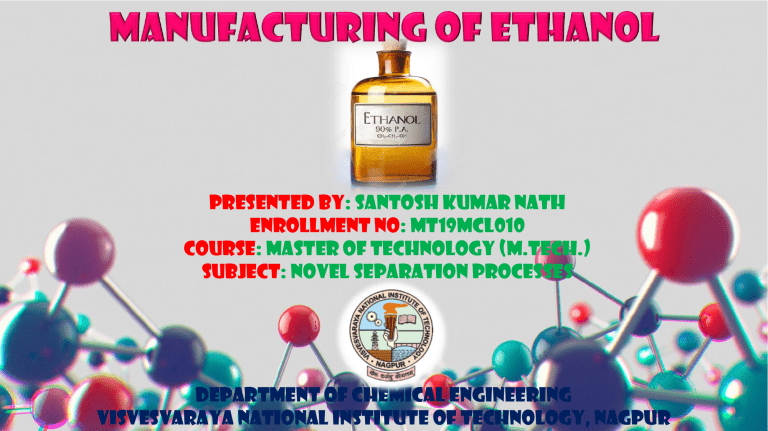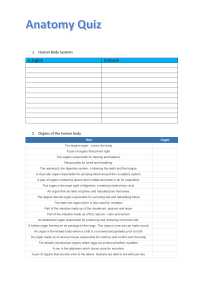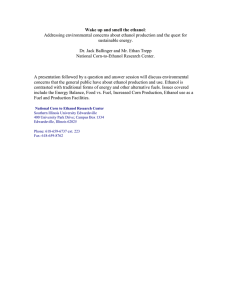
Presented By: SANTOSH KUMAR NATH Enrollment No: MT19MCL010 Course: Master of Technology (M.Tech.) SUBJECT: NOVEL SEPARATION PROCESSES Department of Chemical Engineering Visvesvaraya National Institute of Technology, Nagpur and is a vital substance used across many different kinds of manufacturing industries. Also used as an alternative fuel source. Source:- https://en.wikipedia.org/ Source:- https://www.indiamart.com/ It is a member of a class of organic compounds that are given the general name alcohols. Also called ethyl alcohol, or simply alcohol. Volatile, flammable, colorless liquid with a slight characteristic odor. Principal active ingredient found in alcoholic drinks. Naturally produced by the fermentation of sugars by yeasts or via petrochemical processes. Commonly consumed as a popular recreational drug. Widely used as a chemical solvent, either for scientific chemical testing or in synthesis of other organic compounds, Source:- https://study.com/ Source:- https://www.vectorstock.com/ STRUCTURE OF ETHANOL PHYSICAL & CHEMICAL PROPERTIES Pure Ethanol Chemical Formula C2H6O Molar Mass 46.069 g/mol Appearance Colourless liquid Density 0.7893 g/cc (at 20 °C) Melting Point −114.14 °C Boiling Point 78.24 °C Solubility in Water Completely miscible Viscosity 1.2 mPa-s (at 20 °C) Refractive Index 1.36 Flash Point 14 °C Vapour Density 1.59 Specific Gravity 0.79 Dipole Moment 1.69 D Source:- https://en.wikipedia.org/ Properties APPLICATIONS MEDICAL: • ANTISEPTIC • ANTIDOTE • MEDICINAL SOLVENT FUEL: • ENGINE FUEL • ROCKET FUEL • FUEL CELLS RECREATIONAL SOLVENT Source:- https://www.assignmentpoint.com/ FEEDSTOCK Source:- https://en.wikipedia.org/ LOW-TEMPERATURE LIQUID MANUFACTURING PROCESSES Ethanol is produced both as a petrochemical, through the hydration of ethylene, as well as via biological processes, by fermenting sugars with yeast. (I). Ethylene hydration (Production of Synthetic Ethanol) Ethanol for use as an industrial feedstock or solvent is made from petrochemical feed stocks, primarily by the acid-catalyzed hydration of ethylene. Chemical reaction: C2H4 + H2O CH3CH2OH (II). Fermentation (Production of Bio-ethanol) Ethanol in alcoholic beverages and fuel is produced by fermentation. Certain species of yeast (e.g., Saccharomyces cerevisiae) metabolize sugar, producing ethanol and carbon dioxide. Chemical reactions: C6H12O6 2CH3CH2OH + 2CO2 C12H22O11 + H2O 4CH3CH2OH + 4CO2 Source:- https://en.wikipedia.org/ RAW MATERIALS FOR ETHANOL PRODUCTION STARCHY MATERIALS: • CORN • OTHER STARCHY MATERIALS LIGNOCELLULOSIC BIOMASS Source:- https://lib.dr.iastate.edu/cgi/ Source:- https://www.slideshare.net/ SUCROSE CONTAINING MATERIALS: • SUGARCANE • SUGAR BEET • SUGAR SORGHUM The ethanol market is expected to register a CAGR of around 6%, during the forecast period. The major factors driving the growth of the market studied are the rising demand for ethanol as biofuel, growing to use in beer production and food processing, and stringent government policies to restrict the usage of fossil fuels. On the flip side, an increase in awareness about the ill effects of alcohol consumption, and the advent of hybrid electric vehicles are likely to hamper the growth of the market studied. Source:- https://www.mordorintelligence.com/ Source:- https://www.mordorintelligence.com/ ETHANOL MARKET OVERVIEW Major Observations: The fuel segment dominated the market and is The surging demand to produce ethanol from corn and sugar is likely to provide opportunities for the market studied, during the forecast period. North America dominated the market across the world, due to increasing regulations and rising demand for the food processing industry. Source:- https://www.mordorintelligence.com/ Source:- https://www.mordorintelligence.com/ likely to grow during the forecast period, owing to increased practice of ethanol blending with gasoline across the world. Industrial Solvent Bactericide/Disinfectant Beverages Personal Care Others





